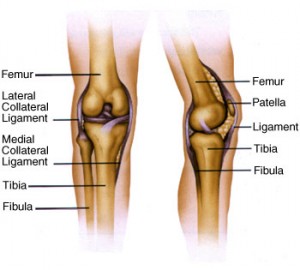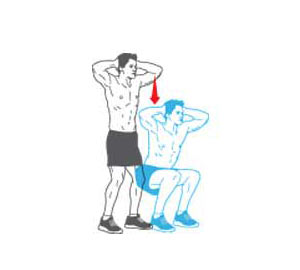Knee Sprain is a condition that affects many athletes and even non-athletes around the world. Read on to know all about the causes, symptoms, diagnosis and treatment of Sprained Knee.
What is a Sprained Knee?
Page Contents

Picture 1 – Anatomy of Knee
Source – 216.74.18.90
It refers to an injury to a ligament of the knee. This usually occurs when a knee ligament is stretched way beyond its usual capacity.
Any person has a risk of suffering from a sprain in the knee. This condition typically occurs when an individual strains his or her knee too much during activities. Over-exercising or walking, jumping or running for a prolonged duration can lead to a sprain in the knee.
MCL Knee Sprain
MCL refers to the Medial Collateral Ligament that is situated on the inner slope of the knee joint. It connects the thigh bone with the shin bone. A sprain of this ligament is referred to as MCL Knee Sprain. Depending on the severity of the injury, the intensity of the sprain can be classified as
First Degree Sprain
The damage is limited to only a few fibres of the ligament. Grade 1 injury is characterized by mild tenderness over the ligament on the inner side of the knee. There is little inflammation involved.
Second Degree Sprain
A more extended number of ligament fibers are damaged in this case, though the ligament remains intact. It is indicated by substantial tenderness and inflammation of the medical ligament. There may be mild pain in the knee joint.
Third Degree Sprain
It involves a complete rupture or tear of the ligament. This type of an injury is caused by a great amount of force that can damage other structures in the knee such as the Anterior Cruciate Ligament and the Meniscus (Cartilage). An athlete with this condition may complaint about an unstable or wobbly knee.
Knee Sprain Braces
Braces are often used for treating a sprained knee. The brace provides support to the knee and takes off the strain from the injured ligament during the initial stages of the injury, especially during sleep. Sprains of second degree are often treated with the aid of braces which restrict but do not eliminate motion of the knees.
Knee Sprain Exercises
Healthcare providers often recommend physical therapy for treatment of sprained knee. Physical therapy consists of exercises and massages to help the injured knee heal and move in a better manner. Once the inflammation and pain from a knee sprain has decreased, your caregiver may train you to perform these exercises. Sprained knee exercises reduce inflammation, prevent stiffness and help the injured knee to perform normal functions with time. Patients are normally advised to perform these exercises two to three times every day.
Some of the best sprained knee exercises to treat the problem are :
Bodyweight Squat

Picture 2 – Bodyweight Squat
Source – victoriawellness
This involves performing squats using only your body weight. This helps put the gluteal muscles and the quadriceps in motion while placing mild strain over the ligaments of the knee. You can use a railing or a wall while squatting halfway down slowly. Gradually return to a standing posture squeezing your calf muscles as you rise up. For more stability, you may perform the squat with half body weight by bending back on a resistance ball.
Stair Exercises
This workout involves bending your knee on a stair or step. It helps to toughen the quadriceps, the big muscles in the thigh that hold the weight of the knee joint. Try to maintain the alignment between the hip, the knee and the ankle as you go up each step. Hold a railing or a bar to support yourself while you step up. You may wear a knee brace while performing step-ups for greater stability.
Leg curls and extensions
A Grade I knee sprain can be cured with the aid of leg curls and extensions that needs to be performed without use of any weight. Sit on a table or bed while fully extending the leg. Hold this posture for about five seconds and then slowly releasing back your leg down. Leg curls can be executed by lying on the stomach and using only the weight of the leg for resistance. Perform three sets of this exercise with 10 repetitions in each set.
How to Treat a Sprained Knee?
Sprained knee treatment is usually done with the aid of RICE which stands for rest, ice, compression and elevation. In the initial days, it is necessary to provide the injured knee with as much rest as possible. Ice should be applied on the injured ligament for 10-15 minutes after every 3-4 hours for three or four days or until the pain subsides completely.
Compression involves wrapping a knee joint with an elastic bandage to decrease flow of blood to the region and reduce inflammation in the area.
Elevation is achieved by lifting up the injured knee from the level of the other parts of the body with the aid of a pillow. This should be typically done when the person has lied down for sleeping.
Severe pain can be tackled with the aid of analgesic (pain-reliever) medications like Ibuprofen (Nuprin, Motrin or Advil). If inflammation lasts for over a week, your doctor can prescribe you some anti-inflammatory medicines to reduce swelling.
Sprained Knee Recovery Time
For individuals suffering from Knee Sprain recovery time depends on the cause and type of the injury. A knee ligament that has a regular sprain without any damage usually heals within 4 to 6 weeks. For a sprained knee healing time also depends on whether enough rest has been provided to the area and treatment such as physical therapy has been carried out. Absence of these measures can prolong the time for recovery and make the ligament vulnerable to greater injury.
Knee Strain Vs Sprain
Knee sprain refers to a strain or an injury of the ligaments occurring due to excessive pressure on them. A knee strain is an injury occurring to the tendon tissues or muscles due to extreme tension.
Sprained Knee is completely curable and goes away with adequate rest, medications and exercises. If you suspect yourself to be suffering from this condition, get in touch with an experienced physical therapist to make an early recovery from the disorder.
References:
http://www.healthscout.com/ency/68/262/main.html
http://www.sprainedknee.net/articles/sprained-knee-recovery-time-frame.html
http://www.sportsinjuryclinic.net/cybertherapist/front/knee/medialligament.htm
http://www.physioroom.com/injuries/knee/medial_collateral_ligament_sprain_full.php

